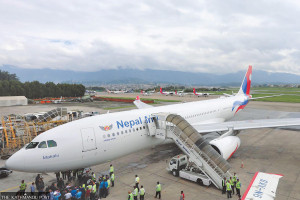Money
Declining visitor numbers threaten peak tourism season
Double-digit slumps in arrivals from India and China, Nepal’s key source markets, has industry worried.
Sangam Prasain
A haphazard decision to close the Kathmandu airport, Nepal’s key gateway, for 10 hours daily has begun to take a toll on the country’s tourism sector, marking the first decline in tourist arrivals since the post-Covid recovery phase.
According to the latest statistics from the Nepal Tourism Board, tourist arrivals in February dropped by 0.6 percent year-on-year to 96,880 individuals. The decline was most pronounced among visitors from Nepal’s key source markets, India and China, both of which recorded double-digit decreases.
On November 8 last year, the Civil Aviation Authority of Nepal announced that Kathmandu’s Tribhuvan International Airport would be closed from 10 pm to 8 am until March 31 for five months to expand taxiways.
Industry insiders said this move was intended to encourage airlines to use newly constructed airports in Pokhara and Bhairahawa, which have struggled to attract significant air traffic.
However, the plan did not work.
Economists warned that the airport closure would come at a critical time, exacerbating the economic slowdown that followed the devastating floods in late September last year.
“This will be a significant setback for Nepal’s fragile economy, affecting not just tourism but also related sectors like transport, hotels, restaurants, telecommunications, and retail,” noted Bishwambher Pyakuryal, a prominent economist, in a recent interview with the Post.
Pyakuryal criticised the government for imposing a “deliberate restriction,” arguing that there were alternative ways to expand airport infrastructure without jeopardising tourism.
The fallout has been severe.
Due to a supply-demand mismatch, airfares have skyrocketed, and prices to popular destinations, including labour markets for Nepali migrant workers, have quadrupled. As a result, many events and travel plans have been scrapped or postponed.
“The airfare remains prohibitively high,” said Mani Raj Lamichhane, director at the Nepal Tourism Board.
“For instance, a return ticket from European countries to Delhi costs around 500 euros, but the same to Kathmandu is 1,500 euros — three times higher. Tourists are thinking twice before choosing Nepal as a destination.”
Despite the onset of the spring season — a peak period for tourism — there is little relief in sight.
“It looks like it will take time for Nepal to return to pre-pandemic tourist levels,” Lamichhane added. “Many countries have already surpassed the pre-pandemic arrivals.”
The decline in Indian tourist arrivals has been particularly concerning for tourism entrepreneurs.
According to Nepal Tourism Board data, Indian arrivals fell by 25 percent to 19,187 in February, following a 15 percent drop in January, when 20,448 Indians visited.
Officials highlight three reasons for the sharp drop in Indian arrivals: Beijing's suspension of the Kailash Manasarovar Yatra, which previously allowed Indian pilgrims to enter Tibet via Nepal; a string of tragic bus and air accidents; and soaring airfares.
“Indian arrivals are crucial for us, and this continued decline is alarming,” said Binayak Shah, president of the Hotel Association Nepal. “We have attended numerous international travel fairs, and the top concern among visitors remains safety—both on the ground and in the air.”
A tragic bus accident in August last year, where a vehicle carrying 43 Indian tourists and crew plunged into the Marsyangdi River, killing 27, further dented confidence. Additionally, a series of air crashes—claiming over 120 lives in the past three years—has added to the anxiety among potential travellers.
“Nepal has not been able to convince the global community that it is taking effective measures to prevent future air disasters,” Shah remarked. “Someone has to do this.”
Chinese tourist arrivals, which had shown promising growth since the reopening of borders and flight resumptions last year, also declined.
In February, arrivals from China dropped by 10 percent to 8,283 individuals. This dip follows a year of steady growth, with Chinese arrivals surpassing the six-digit mark in 2024—a 67 percent increase yearly—totalling 101,879 visitors.
While Beijing declared 2025 “Visit Nepal Year in China”—a move announced during Prime Minister Pushpa Kamal Dahal’s visit to China last September—concerns persist about how effective the campaign will be amid Nepal’s ongoing logistical and safety issues.
Tour operators remain cautiously optimistic, anticipating a potential rebound starting in June when Indian pilgrims resume their Kailash Manasarovar pilgrimage and Tribhuvan International Airport resumes full operations.
However, challenges remain.
According to the annual World Travel and Tourism Council report, tourism is vital to Nepal’s economy, contributing Rs327.9 billion ($2.5 billion) in revenue and supporting 1.19 million jobs directly and indirectly in 2023.
As the country grapples with these challenges, stakeholders stress the urgent need for effective strategies to restore traveller confidence, stabilise airfares, and ensure safety measures—crucial steps in reviving Nepal’s struggling tourism industry.




 18.95°C Kathmandu
18.95°C Kathmandu














